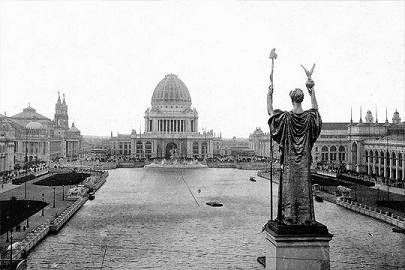In 1892-93 Chicago was transformed into the “White City” for the dazzling World’s Columbian Exposition, also known as the World’s Fair. Presented on the 400th anniversary of Columbus’ arrival in the New World, the Fair was dedicated in October 1892 and ran from May through October of 1893. It covered over 600 acres of downtown Chicago. 200 temporary buildings were erected for the Fair, featuring the work of some of the finest architects and designers of the era: Daniel Burham, Louis Sullivan, Richard Morris Hunt, Charles McKim, landscape architect Frederick Law Olmstead, and many others. There was even a Women’s Building, showcasing female artists, designed by a female architect, Sophia Hayden. The many buildings showcased the arts as well as innovations and industry in America from transportation to mining to electricity. Other attractions included exhibits of international culture, and amusements including the world’s original Ferris Wheel. In addition, many new products and food brands were introduced that would still be recognized today.
Among the exhibits at the Fair, each state had a “pavilion” with which to brag about themselves. In 1891, the Colorado General Assembly created a Colorado Board of World’s Fair Managers. Members included Governor John L. Routt and a number of leading (and wealthy) Colorado men and women, along with several subject-matter experts such as the Secretary of the State Bureau of Horticulture, Dr. Alexander Shaw. Colorado apples were judged highly at the horticultural exhibits, according to the bureau’s 1893 report. Among the other features of the Colorado pavilion was an educational exhibit, the planning for which is described in detail on pages 579-627 in the 1892 Report of the Superintendent of Public Instruction, available from our library. Other Colorado attractions included a re-creation of Mesa Verde and an exhibit of stuffed wildlife. The largest part of the Colorado pavilion, however, was a major exhibition on mining, being such a large part of the state’s industry and economy. Just weeks after the close of the exhibition, however, Colorado’s economy was devastated by the effects of the Crash of 1893. Colorado’s exhibits were very much Western-themed. At this time, there was heightened interest in the West, and Frederick Jackson Turner presented his famous “Frontier Thesis,” proclaiming the closing of the frontier, at the Fair.
The World’s Columbian Exposition with its neoclassical architecture also hugely influenced the City Beautiful movement, which became popular in Colorado, especially under Denver Mayor Speer’s administration in the early 1900s. For example, the Fair’s influence on the architecture of Civic Center Park, though built several decades after the exhibition, is evident.
The Exposition attracted hundreds of thousands of visitors over its six-month run, bringing visitors from all over the world and becoming a significant memory for many people. It also highly influenced American culture and commerce for decades to come.

- How to Spot the Differences Between Eagles and Hawks - August 16, 2021
- How Transportation Projects Help Tell the Story of Colorado’s Past - August 9, 2021
- Time Machine Tuesday: The Night the Castlewood Canyon Dam Gave Way - August 3, 2021